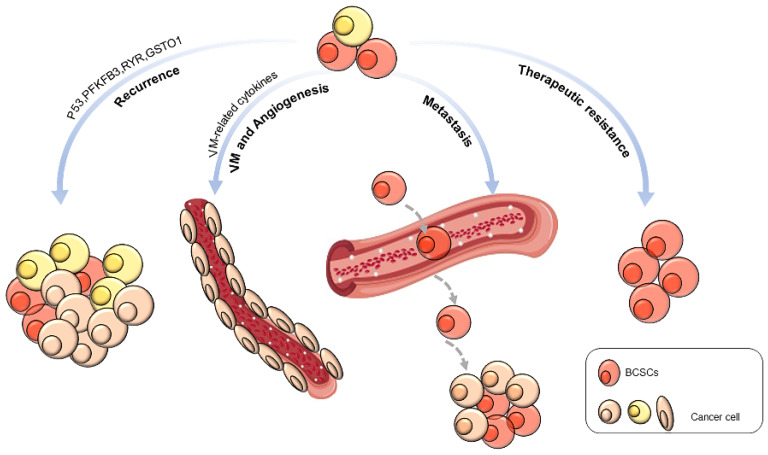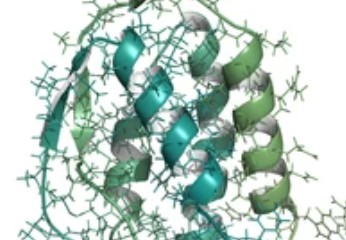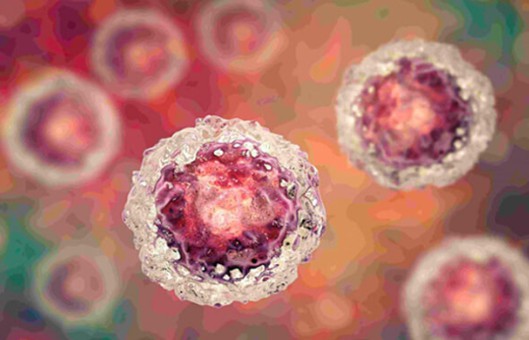Biological Behaviors of Targeted Breast Cancer Stem Cells
International Journal of Biological Sciences. 2023 Jan; 19 (2): 552-570.
Authors: Zhang L, Chen W, Liu S, Chen C.
INTRODUCTION
The potential roles of breast cancer stem cells (BCSCs) in tumor initiation and recurrence have been recognized for many decades. Due to their strong capacity for self-renewal and differentiation, BCSCs are the major reasons for poor clinical outcomes and low therapeutic response. BCSCs are engaged in the physical behaviors of cancer, including recurrence, metastasis, vasculogenic mimicry, angiogenesis, and therapeutic resistance.
Tumor Recurrence
- Emerging evidence suggests that BCSCs promote tumor recurrence, leading to poor prognosis.
- The silencing of p53 promotes the division of BCSCs, increasing their renewal and contributing to tumor recurrence. Inhibition of ryanodine receptor (RyR1) and glutathione S-transferase omega 1 (GSTO1) expression cleared off chemotherapy derivational BCSC enrichment and postponed cancer recurrence. Abnormal expression of 6-phosphofructo-2-kinase/fructose-2,6-biphosphatase 3 (PFKFB3), a gene associated with tumor recurrence, can be suppressed by autophagy activation, keeping BCSCs in a resting state.
 Fig. 1 Biological behavior of BCSCs. (Zhang L, et al., 2023)
Fig. 1 Biological behavior of BCSCs. (Zhang L, et al., 2023)
Vasculogenic Mimicry and Angiogenesis
- Recent studies indicated that BCSCs might contribute to tumor-associated angiogenesis by VM or trans-differentiation.
- CD24-/CD44+ BCSCs are isolated and cultured to differentiate into an endothelial lineage with endothelial markers and properties in the presence of vascular endothelial growth factor (VEGF). They also observed intratumor vessels of human origin in transplanted tumors.
- Using a 3D reconstructed image, the study provided direct evidence of the relationship between BCSCs and VM formation. The CD133+ BCSCs were observed to line VM channels, and breast cancer cells encircled VM channels. They also observed a close correlation between BCSC proportion and VM in invasive breast cancer.
Tumor Metastasis
- CSCs are closely related to tumor metastasis. BCSCs are more metastatic than other types of breast cancer cells, which was realized by increasing the expression of cell metastasis and migration-related proteins while significantly reducing the level of adhesion proteins.
- Inactivation of tumor suppressor genes and activation of oncogenes also regulate the metastatic potential of breast cancer stem cells. Knockout of p21 in a breast tumor model inhibited the self-renewal and lung metastasis of BCSCs. Silencing AKT serine/threonine kinase 2 (AKT2) reduces the invasion and colony formation abilities of BCSCs. Inhibition of RhoC dramatically reduces the probability of lung metastasis of SUM149. Extracellular signal-regulated kinase 2 (ERK2) promotes BCSC self-renewal and lung metastasis, and the knockout of ERK2 significantly inhibits colony formation and mammosphere formation.
Therapeutic Resistance
- Current studies have shown that BCSCs are one of the main reasons for radiation resistance and chemotherapy resistance.
- The drug resistance of BCSCs is mainly caused by the expression of transporters that cause drug efflux and the expression of high-level ALDH1 as a detoxification enzyme to metabolize anticancer substances.
- In addition, BCSCs have a strong DNA damage repair ability and show radiation resistance through high expression of related stemness genes and activation of antiapoptotic and antioxidant signaling pathways.
RELATED PRODUCTS & SERVICES
Reference
- Zhang L, et al. (2023). "Targeting Breast Cancer Stem Cells." Int J Biol Sci. 19 (2), 552-570.


